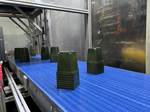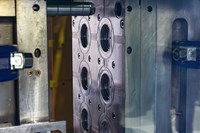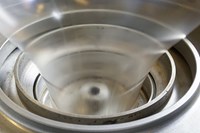First U.S. Lightweight ETFE Film Roof In New Viking Stadium
3M Dyneon's fluoroplastic ETFE high-performance film to start in the first U.S. stadium roof of its kind.
High-performance fluropolmer film, extruded from 3M Dyneon's ethylene-tetrafluoroethylene (ETFE) from 3M, St. Paul, Minn., will cover the first sports facility in the U.S.—the new home of the Minnesota Vikings Football stadium--with a transparent roof, permitting outdoor light without weather restrictions.
Dallas-based firm HKS Architects designed the stadium roof using ETFE film cushion technology, which is already widespread in Europe and Asia, to enable year-round use for a variety of events. The product, which lets light in, is lighter than glass, and more cost-effective than retractable alternatives. The design reportedly lowered construction costs by around $100 million compared to a retractable roof.
The stadium’s 248,000-ft2 asymmetric roof and façade is covered by 75 three-layer ETFE film cushions, making U.S. Bank Stadium the largest ETFE film project in the U.S. Some of the individually air-filled cushions are more than 1200 ft2 long and about 32-ft wide. The top film is printed with a geometric pattern, which scatters the sunlight and prevents a greenhouse effect in summer. In winter, the film roof protects the interior from the cold outside temperatures. The film cushions reportedly allow 95% of daylight to pass through, but their weight is only about 5% of the weight of glass. As a result, the supporting steel structure is light and slender, offering spectators a premium view of the playing field.
In addition, compared to other roofing membranes, ETFE films feature superior value for tear strength, resistance to tear propagation and puncture resistance—which lets the air-filled cushions easily cope with highly concentrated impact loads like hail. Their use in northern Europe and the Alps prove their winter compatibility in areas with heavy snow fall.
Related Content
-
IPEX Opens Injection Molding Facility in North Carolina
The pipe and fittings manufacturer’s new 200,000-square-foot facility represents a $200 million investment and will create 150 jobs.
-
Ineos Nitriles Launches Biobased Acrylonitrile
The company’s Invireo is said to deliver a 90% lower carbon footprint compared to conventionally produced acrylonitrile.
-
EV Chargers Made From Renewable PC
SABIC is enabling Charge Amps to manufacture electric vehicle (EV) chargers with a housing made from certified renewable PC, a first for the industry.







.png;maxWidth=300;quality=90)







